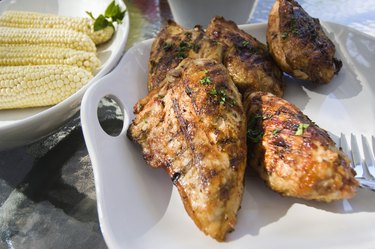
A cooking method causes unique chemical reactions in food and so imparts particular flavors to your meal. However, while many people swear there is no better way to cook meat than to grill it, you have probably pan-fried more meat than you've grilled. Health considerations, convenience, flexibility in the type of cooking needed and other considerations render the decision to fry or grill your T-bone, chicken breast or pork cutlet a matter of practicality and personal choice.
Health
Video of the Day
Both grilling and frying present potential health risks, depending on how you grill and fry. At first blush, frying might seem less healthy. You typically add butter or oil to the pan and your food cooks in whatever additional fat is released into the pan. However, the amount of fat that you drain off in the grill but not in the pan represents a relatively small percentage of the total fat contained in your meat. Further, the interaction of proteins with intense heat during grilling causes the formation of carcinogenic compounds called heterocyclic amines. Consumption of HCAs has been linked to cancer -- particularly to cancer of the colon and stomach, MSNBC.com reports. Charred meat, meat cooked to well done and smoke from burning fat increase HCAs. According to MSNBC.com, routine consumption of HCAs may increase the risk of colon cancer by two to five times and can double or triple the risk of breast cancer. Cooking meat at a lower temperature, whether you fry it or grill it, lowers the number of HCAs.
Video of the Day
Flavor
Both frying and grilling create flavor in meat by applying high heat to protein, triggering Maillard reactions. These chemical interactions between the proteins and sugars create hundreds of different-flavored compounds, giving meat a rich, complex taste. Additional flavor imparted by grilling comes from two sources. Charcoal briquettes are made from hardwood, and food absorbs the smoky wood flavor during grilling. In both charcoal and gas grilling, smoke and flames created by dripping fat chars the meat and imbues the meat with a smoky flavor. However, burning fat increases the HCA content of your food, so this flavor comes at a price.
Convenience
Rain or shine, night or day, you can quickly and easily pan-fry food in the comfort and convenience of your kitchen. For most people, grilling happens outside, away from your fridge, kitchen and cooking supplies. With charcoal grilling, you have the added inconvenience of preparing the coals.
Flexibility
Each method offers a form of flexibility that the other doesn't. You can use indirect heating methods, such as turning off secondary gas burners or distributing your charcoal over only half the grill so that you can roast large cuts of meat on the grill. On the other hand, frying meat in a skillet creates an easy launching ground for other cooking methods. You can brown a steak or roast and then simply add wine or broth to the skillet, cover it with a tight-fitting lid, reduce the heat and slow cook a tough cut of meat until it is fall-apart tender. You can also transfer a steak that you've browned in a cast iron skillet directly into a medium hot oven, skillet and all, to gently finish your seared meat.
Other Considerations
Each method has additional advantages. Frying gives you a degree of temperature control that grilling typically doesn't. On the other hand, grilling gives you an opportunity to spend extra time outdoors and, because it often occurs at outdoor social events, grilling gives the cook some time to mix with guests rather than having to stand lonely vigil at the stove.